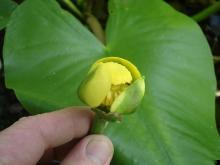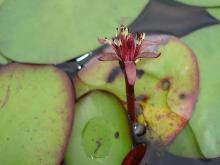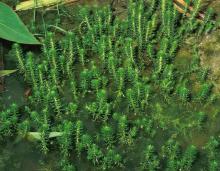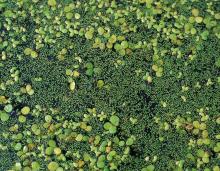Wildflowers, Grasses and Other Nonwoody Plants
Media

Species Types
Scientific Name
Nymphaea spp.
Description
Water lilies are among the most beautiful of all water plants. They have large, round leaves 8–16 inches across, each with a single V-shaped notch.
Media

Species Types
Scientific Name
Nuphar advena (formerly N. lutea)
Description
Spatterdock is a native aquatic plant with deep yellow, saucer-or globe-shaped flowers to 3 inches across. It grows in ponds, lakes, and slow-moving to stagnant portions of streams, rivers, and spring branches.
Media

Species Types
Scientific Name
Brasenia schreberi
Description
Water shield is a long-stemmed aquatic plant with floating oval leaves that resemble small water lily leaves, only without a split. The stems and lower leaf surfaces have a thick, jellylike coating.
Media

Species Types
Scientific Name
Potamogeton spp.
Description
Pondweeds are rooted aquatic plants with underwater leaves on long, flexible, jointed stems. Some have floating leaves, too, that are differently shaped. Missouri has about 10 species in the pondweed genus.
Media

Species Types
Scientific Name
Nelumbo lutea
Description
American lotus is an aquatic plant with circular leaves that are held above water. The large yellow flowers have an interesting showerhead-like disk at the center.
Media

Species Types
Scientific Name
Myriophyllum spp.
Description
Water milfoils are feathery aquatic plants that grow rooted in shallow water. Their tips emerge above the waterline and bear bladelike, toothed leaves.
Media

Species Types
Scientific Name
Najas spp.
Description
Naiads are slender, narrow-leaved plants that grow completely under water and are rooted to the bottom. They never have broad, floating leaves or conspicuous flowers or seed heads.
Media

Species Types
Scientific Name
Lemna spp.; Spirodella spp.; Wolffia spp.
Description
Duckweeds are the smallest of the flowering plants. They consist of tiny, green, round, leaflike bodies that float on the water’s surface. They are an important food for waterfowl.
Media

Species Types
Scientific Name
Sagittaria spp.
Description
Arrowheads are aquatic plants with erect, usually arrow-shaped leaves and distinctive three-petaled flowers. They are often called duck potatoes because ducks, geese, and swans relish the tuberlike rootstocks.
Media

Species Types
Scientific Name
Phytolacca americana
Description
A tall, smooth, branching plant with red stems and juicy, dark purple berries, pokeweed is both toxic and a traditional edible potherb called poke salat. It is common statewide.
See Also
About Wildflowers, Grasses and Other Nonwoody Plants in Missouri
A very simple way of thinking about the green world is to divide the vascular plants into two groups: woody and nonwoody (or herbaceous). But this is an artificial division; many plant families include some species that are woody and some that are not. The diversity of nonwoody vascular plants is staggering! Think of all the ferns, grasses, sedges, lilies, peas, sunflowers, nightshades, milkweeds, mustards, mints, and mallows — weeds and wildflowers — and many more!





















